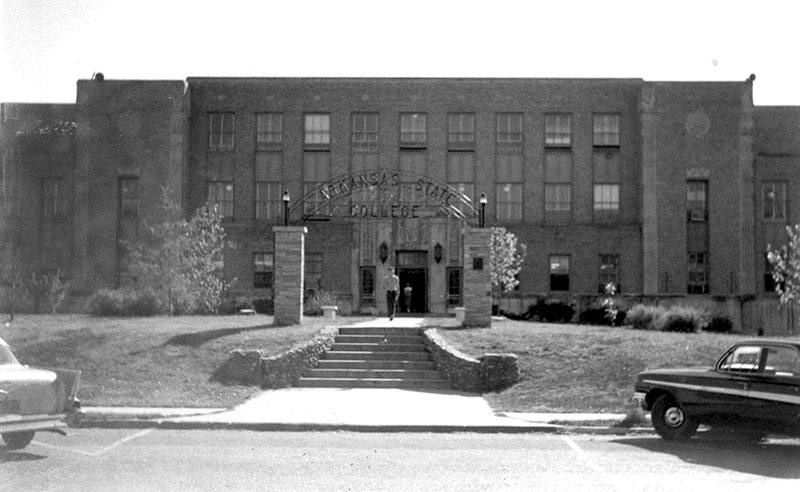Historic A-State Core Added to National Register of Historic Places

The Arkansas State College sign marked the entrance to Wilson Hall, about 1960. Completed in 1932, Wilson Hall is the oldest building on campus. It stands in the heart of the Arkansas State College Historic District, recently listed on the National Register of Historic Places.
JONESBORO – The historic campus core of Arkansas State University is among a group of Arkansas properties just listed on the National Register of Historic Places.
The new listings were announced by the Department of Arkansas Heritage and the Arkansas Historic Preservation Program, which prepared the 93-page application.
The new listings include the Arkansas State College Historic District, which forms the historic core of Arkansas State University. This area is significant “for its contribution to the progress of higher education in northeast Arkansas. It is also important for its International Style and Art Deco style architecture, which was built from the 1930s through the 1960s,” the announcement said.
Wilson Hall, named for institution benefactor R. E. Lee Wilson and completed in 1932, is the oldest of the buildings in the historic district. Erected as the young college’s primary academic and administrative building, it was a Depression-era replacement for the original classroom and administration building that was destroyed by fire in 1931.
Also included are the Computer Science and Mathematics Building, built in 1936 as the Teacher Training School and home to programs in education, and the Griffin College of Business building, which was erected in 1939 as the Science Building, for science and military training programs.
Memorial Arch, in the center of the district, was a gift from the Training School graduating class of 1927. At that time, the institution was known as A&M College, the name inscribed on the south face of the arch.
Newer buildings in the historic district that contributed to the listing include University Hall, 1962, the Administration Building, 1965, Kays Hall, 1966, and Fine Arts Center, 1967.
The application summary noted, “ . . . the design of the campus mainly reflects its appearance during the period of significance . . . the individual buildings in the district still retain, for the most part, their workmanship from the time that they were built, and the district still has the feel of a college campus.”
Two other A-State properties are already on the National Register. The V.C. Kays House on Aggie Road was added in 2014, and the Johnny Cash Boyhood Home, an A-State Heritage Site, at Dyess was added in 2018.
“The National Register of Historic Places is a popular project of the Arkansas Historic Preservation Program,” said Marty Ryall, director of the Department of Arkansas Heritage. “Properties listed on it stand out for their historical, cultural and architectural significance.”
The Arkansas Historic Preservation Program (AHPP) administers the state’s participation in the National Register of Historic Places, a National Park Service program.
“The National Register is the country’s official list of historic resources that are worthy of preservation,” added Ralph Wilcox, national register and survey coordinator and deputy state historic preservation officer for AHPP. “Having properties in Arkansas listed on the National Register is important for several reasons. Listing a property on the National Register documents that property’s history and its importance in the state and the local community. It helps people to learn about and understand more about the state’s history.”
The Arkansas properties that were added recently span a wide range of historic and architectural scope. Details are available through the Department of Arkansas Heritage website.





